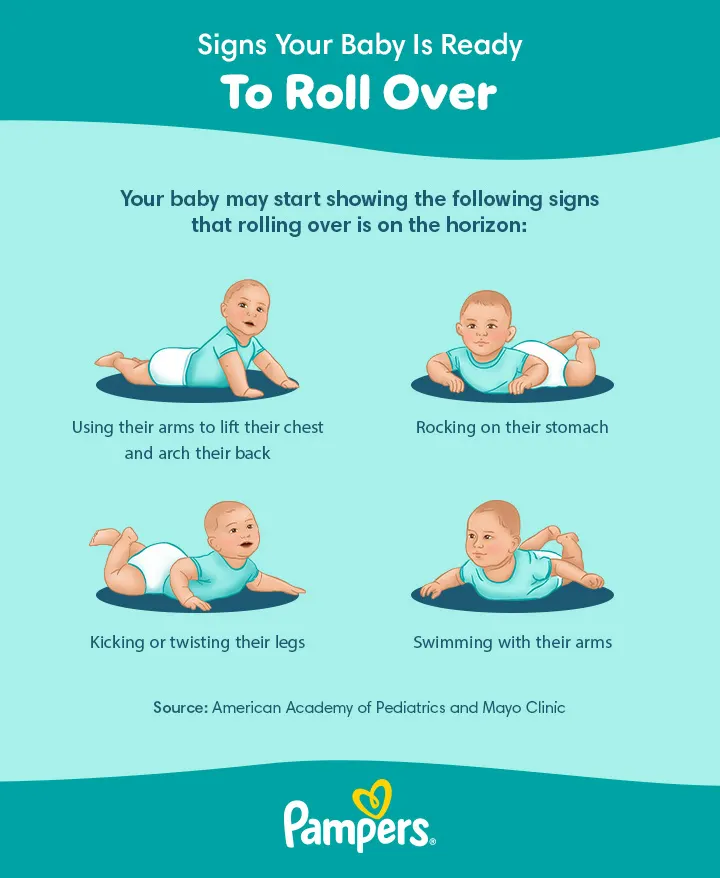What Age Do Babies Start Rolling Over?
Your baby is already growing and developing right before your eyes, becoming more mobile and alert by the day. As you start to anticipate exciting milestones, get prepared for rolling over, one of the earliest developments to occur. Read on to learn more about at what age babies typically roll over, how to encourage your baby to roll and what to do if your little one isn’t rolling over.
When Do Babies Roll Over?
Many parents ask themselves the question, ‘When should my baby roll over?’ Remember that every baby is different, and reaching common developmental milestones will happen at their own unique pace. So, when do babies start rolling over? It will vary from child to child. While some babies do start to roll over as early as 3 or 4 months old, when most babies start rolling is closer to 7 months.
When Do Babies Start to Show Signs of Rolling Over?
Some of the very first signs of when your baby might start rolling over include wriggling and kicking while on their tummy. Tummy time is important, as it helps your little one to build the muscle and strength they’ll need to first roll, which is the first step towards crawling and moving around. At around 5 months old to 7 months old your baby may start to show the following signs that rolling over is on the horizon:
Using their arms to lift their chest and arch their back
Rocking on their stomach
Kicking or twisting their legs
Swimming with their arms.
Developing these kinds of gross motor skills is necessary for your baby to be able to eventually roll over, crawl, sit up and even start walking.
When Do Babies Roll From Tummy to Back, Back to Belly?
So, which way do babies roll first? It’s most common for babies to first learn to roll from front to back before being able to roll from back to front. Here’s why:
Rolling belly to back. As your baby learns to push themselves up with their arms while enjoying tummy time, they’ll often do so unevenly, which causes them to roll over.
Rolling back to belly. Rolling from their back to their belly requires more encouragement and movement, so it often happens after learning how to roll from front to back.
So, when can babies roll over in both directions? By around 7 months, many babies may be able to roll over in both directions.
At What Age Do Babies Roll Over Easily?
As already mentioned, those first rolls often happen anywhere between 4 and 7 months. But remember that this ‘rolling over’ milestone, like other developmental achievements, could happen at a different time for an individual baby. However, once your little one gets the hang of it, their muscles will continue to develop and strengthen, making rolling over easier and easier.
You might be wondering if your baby has begun rolling over too early or too late. Although it’s unlikely for a baby to begin rolling over before 4 months, for example, it doesn’t mean it’s impossible. And looking at it from the opposite perspective, don’t be surprised if your baby is not rolling over at 5, 6 or 7 months – every baby develops differently. Be patient, as there’s still time.
How to Help Your Baby Roll Over
There are many ways you can help your baby learn how to roll over, all falling into the fun theme of play. Spending lots of time on the floor with your little one is the trick, combining time on their back with tummy time and moments on their side.
How to Encourage Your Baby to Roll Over
If you’re asking the question, ‘When do babies start to roll over?’ you might also wonder how to help encourage your adventurous baby to start rolling over. The answer is, of course, tummy time, which we mentioned above. Tummy time is an activity that you can start when your baby is a newborn infant, starting by letting them lay on your chest. As you transition to the floor, you can practice rolling over by placing your baby on their tummy for short periods with you close at hand. Use a toy or favourite blanket to encourage them to reach and, eventually, turn over.
Movements on the tummy, back and sides are all different and will build muscle strength. Here are some tips for how to encourage your baby to roll over:
Spend lots of time on the floor in different positions, on the back, tummy and sides, playing with toys.
Use tummy time (and time on the back and sides) to help your baby build their muscles, encouraging them to lift their head by showing them a toy.
Place a rolled-up towel under your little one’s arms if they need a little help lifting their head or pushing up.
To encourage rolling over from back to front, place a toy on their side and gently bring the leg on their other side over their body so they get used to the movement and feeling.
When on their tummy, move your baby’s legs and arms in a swimming motion to encourage the movements needed to eventually roll over.
Only practice tummy time and these other movements when your little one is awake and alert, and you can keep an eye on them.
Watch the video below to learn how to help your baby roll over:
When Do Babies Start to Roll Over: Safety
As your baby works on these exciting new skills, keep a close watch on them, especially when you have them on a high surface like a changing table, bed or sofa. It's safest to always keep a hand on them to prevent them from rolling over and onto the floor. Baby proofing your home is a never-ending task during those first years, especially if this period of exploration is just around the corner. You might have already done some babyproofing, but now's a good time to take a second look with your more mobile and curious little one in mind.
What To Do If Your Baby Is Rolling Over in Their Sleep
For the first six months, you’ll want to place your baby in the same room as you and on their back when sleeping. This reduces the risk of Sudden Infant Death Syndrome (SIDS) and cot death. With your little one in the same room as you, you can check on them regularly, and sleeping on their back reduces the risk of suffocating, as does removing anything from their cot besides the mattress and a tight-fitting sheet. When your baby starts to roll over, you won’t have to worry about them sleeping on their side or stomach, as they can roll back over to a safe position when needed.
What to Do If Your Baby Isn’t Rolling Over
Your little one may reach certain milestones sooner than others, or they may take a little extra time to master certain skills. This is normal – every baby is an individual and develops at their own speed. If you're concerned your baby hasn't rolled over by the time they’re 6 or 7 months old, mention it to your health visitor. Keep in mind that premature baby development typically happens later for those born before 37 weeks.
What’s The Next Milestone After Rolling Over?
When wondering when babies should roll over, your next thoughts may very well be, when can a baby crawl, when do babies start to sit up and at what time do babies usually walk? All this physical movement and progression are related. Building muscles with tummy time is a prerequisite to rolling over. As a result, the next milestones usually go in this order:
Sitting up with your support
Sitting up on their own
Transitioning from laying down to sitting up
Crawling
Standing up with support from you or furniture
Standing up on their own
Walking
Just remember that all babies develop in their own unique way. So, some might even skip a milestone altogether and move on to the next. Or some babies might need a little more time with one milestone, then blast through the next one. You can always mention any questions or concerns at your next health visitor visit, as they’re a good source of support and information related to your little one’s growth and development.
FAQS AT A GLANCE
It’s possible that a baby could roll over at 3 months, but it’s not likely. Babies develop at their own pace, so some might start to roll over earlier than others. First, they need to have the necessary muscles and coordination to do so, which is why tummy time is so important. It’s more common for babies to roll over around 6 or 7 months old.
The Bottom Line
Your baby’s first years are an exciting journey of growth and development. With plenty of supervised tummy time, they’ll build and strengthen the muscles and coordination they’ll need to start rolling over. After that, they’ll continue building up their movement, eventually sitting up, crawling and walking, all within their own timeline. Answering the question, ‘When do babies start to roll over?’ requires an age range, as rolling over is a developmental milestone that can happen as early as 4 months or around 6 or 7 months or even later. If your little one needs more time to master this skill, that’s OK, too, especially if they were born early, before 37 weeks. Be sure to connect with your health visitor with any questions or concerns as they track your baby’s growth and development. Whether your baby is loving tummy time or starting to show signs of wriggling and rolling, they’ll be on-the-go soon enough! Time flies, so enjoy these precious moments and milestones as they come. One thing all babies need at every age, however, is nappies. To earn cash for all your Pampers nappies and wipes purchases, download the Pampers Club app today!
How We Wrote This Article The information in this article is based on expert advice found in trusted medical and government sources, such as the National Health Service (NHS). You can find a full list of sources used for this article below. The content on this page should not replace professional medical advice. Always consult medical professionals for full diagnosis and treatment.
Read more about Newborn Baby
Join Pampers Club and get:






